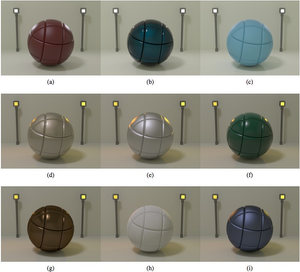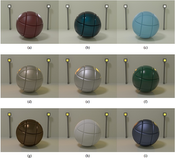Information
- Publication Type: Other Reviewed Publication
- Workgroup(s)/Project(s): not specified
- Date: 2009
- Booktitle: SIGGRAPH Asia 2009 Courses
- Location: Yokohama, Japan
- Publisher: webpage: http://portal.acm.org/citation.cfm?id=1665824
- Conference date: 16. December 2009 – 19. December 2009
Abstract
This course serves as a guide on the considerable potential of layered surface models. The key advantage of using such layered BRDFs over traditional, more general shading language constructs is that the end result is automatically highly physically plausible.In particular, we demonstrate on a simple layered surface model that combines several traditional BRDF components how a surprisingly large number of interesting and important surface types can be efficiently represented by using the same, not particularly complex, BRDF code. We also show how handy such an approach is for the eventual end user, whose main concern is the ease with which one can describe object appearance based only on a few intuitive parameters.
We first discuss layered surface models in computer graphics and the constraints of modelling object appearance in a physically plausible fashion. We then demonstrate the techniques that can be used to efficiently evaluate layered BRDF models, give examples of the surface types that can be described in this way. We also go beyond plain surface models, and showcase how a texture-based combination of layered surface components can be used to describe highly complex object appearance attributes, while implicitly remaining physically plausible.
Additional Files and Images
Weblinks
No further information available.BibTeX
@inproceedings{weidlich_2009_EPLBM,
title = "Exploring the Potential of Layered BRDF Models",
author = "Andrea Weidlich and Alexander Wilkie",
year = "2009",
abstract = "This course serves as a guide on the considerable potential
of layered surface models. The key advantage of using such
layered BRDFs over traditional, more general shading
language constructs is that the end result is automatically
highly physically plausible. In particular, we demonstrate
on a simple layered surface model that combines several
traditional BRDF components how a surprisingly large number
of interesting and important surface types can be
efficiently represented by using the same, not particularly
complex, BRDF code. We also show how handy such an approach
is for the eventual end user, whose main concern is the ease
with which one can describe object appearance based only on
a few intuitive parameters. We first discuss layered
surface models in computer graphics and the constraints of
modelling object appearance in a physically plausible
fashion. We then demonstrate the techniques that can be used
to efficiently evaluate layered BRDF models, give examples
of the surface types that can be described in this way. We
also go beyond plain surface models, and showcase how a
texture-based combination of layered surface components can
be used to describe highly complex object appearance
attributes, while implicitly remaining physically plausible.",
booktitle = "SIGGRAPH Asia 2009 Courses",
location = "Yokohama, Japan",
publisher = "webpage: http://portal.acm.org/citation.cfm?id=1665824",
URL = "https://www.cg.tuwien.ac.at/research/publications/2009/weidlich_2009_EPLBM/",
}


